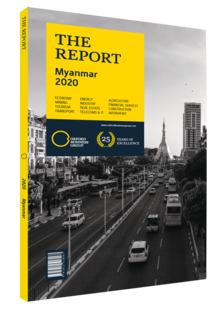Plans under way for universal health care in Myanmar
In 2015 the government of Myanmar laid out the goal to provide universal health care (UHC) by 2030. The aim of UHC is to ensure that every citizen can access high-quality services without experiencing financial hardship. The World Health Organisation (WHO) uses three metrics to measure the success of UHC schemes: coverage of essential health services; protection against financial risk; and population coverage. However, a report evaluating Myanmar’s progress towards UHC – published in July 2018 by researchers at the University of Tokyo, using data from the latest Myanmar Demographic and Health Survey 2015-16 – shows the country has some way to go in each of these areas.
Regarding the first metric, the extent of coverage of essential services is far below the WHO target of 80%. While this varies by indicator, the majority were below 60% in 2016, ranging from 27.6% coverage of postnatal care for newborns to 87.8% administration of the Bacillus Calmette-Guérin immunisation for tuberculosis. The report also cites high financial risk carried by the population due to expensive out-of-pocket payments (OOPPs). Citizens living in the richest areas of the country are most exposed to medical financial risk, as they have the greatest access to such services. Meanwhile, patients in remote areas are often deterred from seeking primary health care at all because of limited quality of services, overcrowded hospitals and clinics, or the large distances between health care facilities.
System Financing
Three national health plans (NHPs), each covering a five-year period, map the road to UHC by 2030. The first of these, spanning 2017-21, aims to provide the entire population access to a basic essential package of health services (EPHS) – before moving on to an intermediate and comprehensive EPHS in later NHPs – and to improve financial protection.
While the government’s budgetary allocation to the Ministry of Health and Sports has increased substantially over time, Myanmar’s proportion of health funding to the national budget is one of the lowest in the region, at 3.8% in 2019/20, or MMK1.07trn ($697.5m), down from 4.5% in 2018/19, or MMK1.13trn ($736.6m). The sector also receives a large amount of funding from external sources. According to the 2018 evaluation report, overseas development assistance accounted for 21.8% of total health expenditure in 2014.
OOPPs, meanwhile, accounted for 51% of expenditure that year, representing the highest proportion in the region, although this was down significantly from 79% in 2011. The WHO advises that OOPPs comprise less than 30% of health spending for the realisation of UHC. The NHP 2017-21 makes clear the need to increase the efficiency of public health care expenditure to reduce the financial burden on citizens, while also recommending instituting a mechanism to collect and manage philanthropic donations and corporate social responsibility contributions from private businesses.
Overcoming Hurdles
To reduce financial risk at the point of care, policymakers could look to other countries in the region. Thailand and Vietnam, for instance, finance their health systems primarily through social health insurance that is funded by income tax. Indeed, the findings of a survey in the International Journal of Health Planning and Management in 2018 point to significant interest in health insurance in Myanmar, with 75% of respondents expressing a willingness to enrol in an insurance scheme. Rather than a structure similar to the one employed in Thailand, however, Myanmar respondents expressed a preference to pay a monthly sum of MMK2000-4000 ($1.30-2.61) into a fund managed by the government. Increasing health insurance penetration would go a long way to minimise high OOPPs. Progress towards UHC would be further catalysed by a greater volume of data that is representative of care-seeking behaviour among the population. This would enable more efficient identification and prioritisation of health issues and, in turn, the appropriate allocation of resources. This should be accelerated by improved digitalisation (see overview).
You have reached the limit of premium articles you can view for free.
Choose from the options below to purchase print or digital editions of our Reports. You can also purchase a website subscription giving you unlimited access to all of our Reports online for 12 months.
If you have already purchased this Report or have a website subscription, please login to continue.

